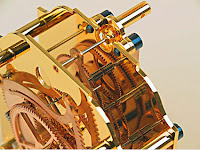The man first began to tame time with a cane and rope, but then he realized that he needed more accurate devices that, on the other hand, needed to be equipped properly – and so the clockmakers became very important people.
Few people in "the old times" could have been measured with clockmakers. They were, then, so prominent that a place was given to them along with the ruler himself who - believe it or not - allowed them to work, when and how much, they wanted. Their craft was valued not only as the supreme art, but also because rulers of old times liked to have them close, in sight, because they were those who have ruled the art of taming time. And the rulers have always had an urge to keep everything under their cloak, so why not even the time.
However, until the beginning of the second half of the 16th century, clockmakers were, some would say undeservedly, named only as machinists, or, maybe they were deliberately named like this due to the fact that their skills implied some kind of turnkey of time. In the summer of 1565 the first clock guild association was formalized and it received new members strictly by the book. Within a year, a candidate had to produce two clocks. One was supposed to be a table clock, with the repetition on each quarter, with a scale of 24 hours on the first dial, while on the second a the scale was supposed to be set for a quarter hours and with moon phase indicators, and on the other side, the annual calendar and day lengths. So, in a way, it was almost a device that comprehensively recorded the passage of time. The second clock that was supposed to be made on this, for the future clockmaker, key year, had to be pendent-like (one that is worn around the neck), and it had to had an alarm that came out on every hour. The owners, of course, took off this kind of clock, at bedtime, but also in other (similar) situations.
After all, clocks have been for a long time a matter of prestige, a nice part of room decoration, but also an important ornament when going out among other people. Until recently, "watching at a clock" was a real little ritual that could have lasted even ten minutes, while slowly opening the boxes, one by one, listening, showing it to the environment and, ultimately, unquestionably stating what time is it. And if the clock had the suitable, often overemphasized, chain, the owner of the clock reflected a unique impression of its importance.
To read Guardians of Time (Part II: Stomach More Accurate Than All), click HERE.
Few people in "the old times" could have been measured with clockmakers. They were, then, so prominent that a place was given to them along with the ruler himself who - believe it or not - allowed them to work, when and how much, they wanted. Their craft was valued not only as the supreme art, but also because rulers of old times liked to have them close, in sight, because they were those who have ruled the art of taming time. And the rulers have always had an urge to keep everything under their cloak, so why not even the time.
However, until the beginning of the second half of the 16th century, clockmakers were, some would say undeservedly, named only as machinists, or, maybe they were deliberately named like this due to the fact that their skills implied some kind of turnkey of time. In the summer of 1565 the first clock guild association was formalized and it received new members strictly by the book. Within a year, a candidate had to produce two clocks. One was supposed to be a table clock, with the repetition on each quarter, with a scale of 24 hours on the first dial, while on the second a the scale was supposed to be set for a quarter hours and with moon phase indicators, and on the other side, the annual calendar and day lengths. So, in a way, it was almost a device that comprehensively recorded the passage of time. The second clock that was supposed to be made on this, for the future clockmaker, key year, had to be pendent-like (one that is worn around the neck), and it had to had an alarm that came out on every hour. The owners, of course, took off this kind of clock, at bedtime, but also in other (similar) situations.
After all, clocks have been for a long time a matter of prestige, a nice part of room decoration, but also an important ornament when going out among other people. Until recently, "watching at a clock" was a real little ritual that could have lasted even ten minutes, while slowly opening the boxes, one by one, listening, showing it to the environment and, ultimately, unquestionably stating what time is it. And if the clock had the suitable, often overemphasized, chain, the owner of the clock reflected a unique impression of its importance.
To read Guardians of Time (Part II: Stomach More Accurate Than All), click HERE.









0 comments: on "Guardians of Time (Part I: The Time Has Come)"
Post a Comment